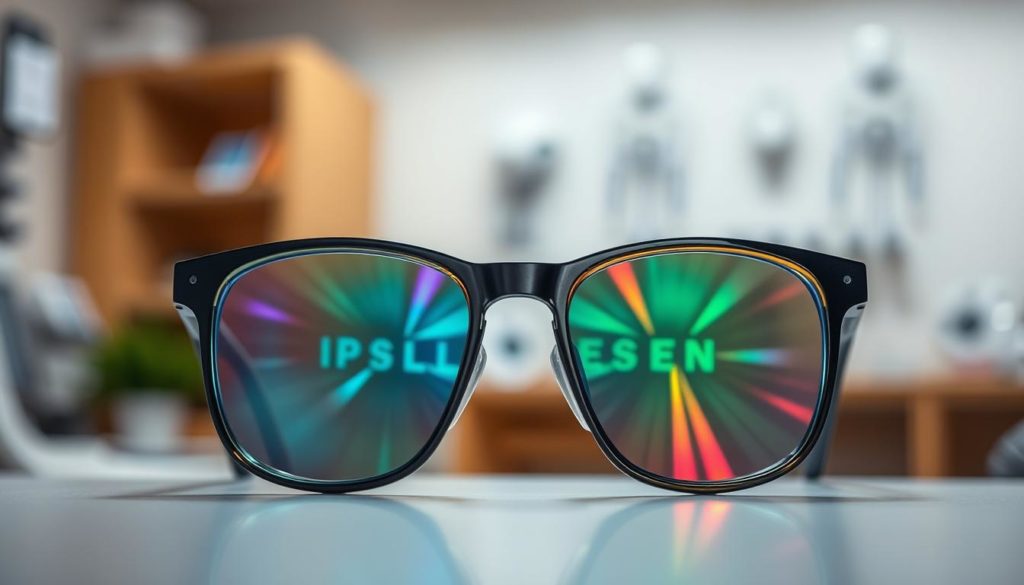Did you know that nearly 12 million Americans suffer from chronic visual misalignment issues? These can be significantly improved with prism lenses. These specialized lenses are a game-changer in the world of vision correction, yet many people are unaware of their potential.
So, what are prism lenses? These remarkable lenses are designed to compensate for eye alignment problems. They provide enhanced clarity and improved eye health. Unlike standard lenses, prism lenses work by bending light before it enters the eye. This effectively aligns vision to correct issues like double vision or convergence insufficiency.
In the coming sections, we’ll delve into comprehensive prism lenses information. We’ll explore their history, development, and the science behind them. We’ll examine the various types available and the distinct benefits they offer for eye comfort and clarity. Let’s embark on this enlightening journey to see how prism lenses can transform your vision and overall eye health.
What Are Prism Lenses?
Prism lenses are key for those looking for good vision correction. They change light’s path to fix double vision and eye alignment issues.
Definition of Prism Lenses
Prism lenses are special glasses that bend light before it hits your eye. This helps fix vision problems like double vision. They make sure images focus right on your retina, improving your vision.
History and Development of Prism Lenses
The history of prism lenses is filled with big steps in vision care. It started with Isaac Newton’s work in optics. Over time, these lenses have gotten better, thanks to new research and technology.

Understanding Prism Lenses
Prism lenses are key in fixing many vision problems. They work by bending light, helping our eyes see clearly. This makes them important for correcting vision and clearing up common misunderstandings.
The Science Behind Prism Lenses
Prism lenses use the science of light refraction. They bend light before it hits the eye, helping it focus right on the retina. This is especially helpful for people with binocular vision issues, where the eyes struggle to align images.
These lenses change the light’s path with special angles and cuts. This helps fix problems like double vision and eye misalignment. Their design shows how light refraction can fix complex vision problems.

Common Misconceptions About Prism Lenses
Many people think prism lenses are heavy and ugly. But today’s lenses are thin and stylish, and they don’t lose their effectiveness.
Some also believe prism lenses are only for very bad vision. But they can be made for all sorts of vision needs, from small binocular vision issues to more serious problems.
Learning more about prism lenses can clear up these myths. It shows how they improve our vision and eye health.
Types of Prism Lenses
It’s important to know about the different prism lenses. They help with various vision problems. Let’s look at the main types of prism lenses.
Single Vision Prism Lenses
Single vision prism lenses fix vision at one distance. They’re great for people with presbyopia or astigmatism. These lenses are easy to use and popular among many.
Bifocal Prism Lenses
Bifocal prism lenses have two powers in one lens. They help you see up close and far away. They’re perfect for those with presbyopia, making it easy to switch between reading and distance vision.
Progressive Prism Lenses
Progressive prism lenses are a top choice. They have multiple focal points without visible lines. They’re good for presbyopia or astigmatism, offering smooth vision correction. They’re also stylish, making them a favorite for many.
| Lens Type | Function | Suitable For | Advantages |
|---|---|---|---|
| Single Vision Prism Lenses | Correction at one distance | Presbyopia, Astigmatism | Simplified, effective |
| Bifocal Prism Lenses | Dual optical powers | Presbyopia | Versatile, convenient |
| Progressive Prism Lenses | Multiple focal points | Presbyopia, Astigmatism | Smooth transition, aesthetic |
Benefits of Prism Lenses
Prism lenses offer many benefits, especially for those with vision problems related to binocular vision. They help ensure proper optical alignment and fix issues caused by binocular disparity.
Enhanced Clarity and Vision
Prism lenses are great at making vision clearer and sharper. They correct eye alignment, reducing visual distortions. This leads to a more accurate view of the world.
This better vision quality greatly improves one’s quality of life.
Improved Eye Comfort
Prism lenses also reduce eye strain and discomfort. Poor eye alignment can cause headaches, double vision, and fatigue. Prism lenses fix these issues, making eyes more comfortable.
With clearer vision, less discomfort, and better optical alignment, prism lenses are very helpful. They can greatly enhance one’s quality of life by offering a more comfortable and clear vision experience.
Prism Lenses Uses
Prism lenses play a key role in treating various vision problems. They are great for treating double vision and fixing eye misalignment like strabismus. Regular use leads to better vision and a better life for patients.
Treating Double Vision
Prism lenses are mainly used for Diplopia Treatment. Double vision can make daily tasks hard. Prism lenses help by aligning the images from each eye, creating a single clear picture. This is crucial for patients to feel confident in their vision again.
Correction for Eye Misalignment
Prism lenses are also great for strabismus, where eyes don’t align. This can lead to serious vision issues if not fixed. Prism lenses redirect light to align both eyes on the same point. This helps in correcting vision and reduces discomfort from strabismus.
| Condition | Prism Lens Benefit |
|---|---|
| Diplopia | Aligns dual images into a single clear image |
| Strabismus | Corrects eye misalignment, improving overall vision |
How Prism Lenses Work
Prism lenses work by changing how light bends in the eye. This helps fix vision problems and improves eye coordination. They make seeing clearer and more comfortable.
Refraction Principles
Prism lenses use light refraction to move images to the right spot in the eye. The prismatic power in the lens bends light. This corrects vision problems like double vision and misalignment.
These lenses adjust where light enters the eye. This makes images seen by each eye line up better. It reduces eye strain and makes seeing more comfortable, especially for complex vision needs.
Implementing Prism In Eyewear
Adding prismatic power to glasses is a precise process. Optometrists measure the prism correction needed for each eye. They then put this into the lenses.
There are different types of prism lenses, like single vision and bifocal. They can be made to fit specific vision needs. The design ensures the lenses are comfortable and look good too. Advances in therapeutic optics have made these lenses better and more available for many people.
Prism Lens Prescription
An Eye Care Professional is key in getting a prism lens prescription. They do a detailed Optometric Evaluation. This includes tests to see if you need prismatic correction.
The first step is a medical history review. Then, they do several specialized tests. These tests check your eye health and how well you see.
After finding out if you need prism lenses, they prescribe the right strength and direction. This helps fix problems like double vision or eye misalignment.
Here’s what the evaluation might include:
- Refraction assessment to determine the power of lenses needed
- Binocular vision testing to evaluate how well your eyes work together
- Alignment tests to observe how your eyes align when focusing
The tests help the Eye Care Professional create a Customized Vision Solution. This solution is made to fix your specific vision problems. So, the prism lens prescription you get will improve your vision and make it more comfortable.
It’s crucial to see your Eye Care Professional regularly. This ensures your prism lenses still work well as your vision changes. Adjustments might be needed, showing the importance of ongoing Optometric Evaluations for your eye health.
Corrective Prism Lenses
Corrective prism lenses are special. They help with more than just regular vision problems. They are made for people with double vision and eye misalignment. This makes them a key part of personalized eyecare.
Differences Between Corrective and Regular Lenses
Corrective prism lenses are different from regular lenses. Regular lenses fix nearsightedness or farsightedness. But prism lenses adjust light to fix image direction on the retina. This is why they’re important in vision therapy for certain eye problems.
Customization and Lens Fitting
Getting prism lenses right is all about customization and fitting. Each lens is made just for the person, with the right amount of prism. New technologies help optometrists give better personalized eyecare. A careful fitting makes sure the lenses work well and feel good.
FAQ
What are prism lenses?
Prism lenses are special optical lenses. They correct vision by redirecting light to the retina. This helps in clearer vision and better eye alignment.
How do prism lenses work?
Prism lenses bend light before it hits the eye. This corrects eye misalignment. It ensures both eyes work together for clearer vision.
What conditions do prism lenses treat?
Prism lenses treat double vision and strabismus. They also help with eye strain and headaches from binocular vision issues.
Are there different types of prism lenses?
Yes, there are single vision, bifocal, and progressive prism lenses. Each type meets different vision correction needs.
How are prism lenses different from regular lenses?
Prism lenses correct eye alignment by bending light. Regular lenses don’t do this. They improve vision and eye coordination.
Can prism lenses be customized?
Yes, prism lenses are customized for each person. An eye care professional determines the needed prismatic power for vision correction.
What are the benefits of using prism lenses?
Prism lenses improve vision clarity and reduce eye strain. They also enhance binocular vision and overall eye comfort.
How are prism lenses prescribed?
Eye care professionals prescribe prism lenses after an evaluation. They assess misalignment and determine the needed prismatic correction.
What is the history of prism lenses?
Prism lenses have evolved over time. Advances in technology have made them more effective and comfortable. Their history shows growing understanding of their benefits.
Are there any common misconceptions about prism lenses?
Yes, some think prism lenses fix all vision problems. But they’re designed for eye alignment and binocular vision issues only.


